Politics
The Troubling Stories Behind Five Monuments Around the World That Came Down in Recent Days—and Why Their Removal Was Long Overdue
Monuments from Boston to Bristol have been targeted by protestors demanding a change.
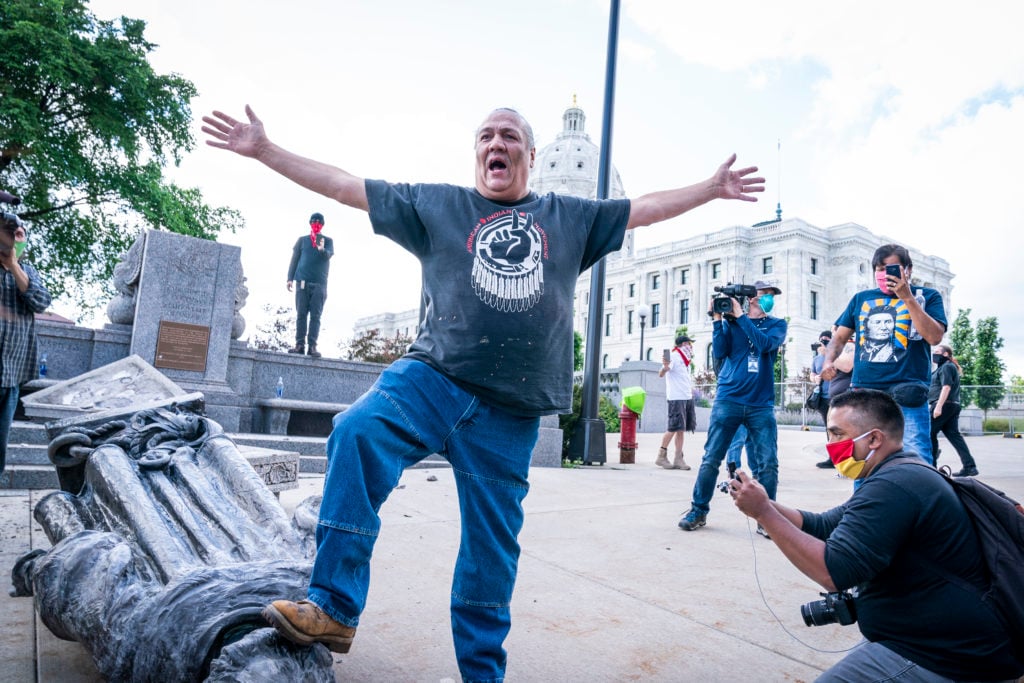
Monuments from Boston to Bristol have been targeted by protestors demanding a change.

Katie White

The monuments were made across centuries and continents—and now their time is up.
In the past weeks, as Black Lives Matter protesters made their way through cities from Boston to Bristol, statues of historical figures once revered and now reviled have been taken down, either by direct action or through quickly organized official removals.
In the US, the dismantling of Confederate monuments in the American South have garnered most of the media attention, though global public ire is mounting against a whole trove of historical characters, from Christopher Columbus to Edward Colston—and with good reason.
Oftentimes, the histories of these monuments are far more complicated and insidious than they seem. They do not simply reflect an outdated ethos. Many of them, instead, speak to the far-reaching cruelties of slavery and colonialism, and the present-day legacies of white supremacy.
Below, we take a closer look at the histories of five recently removed monuments.
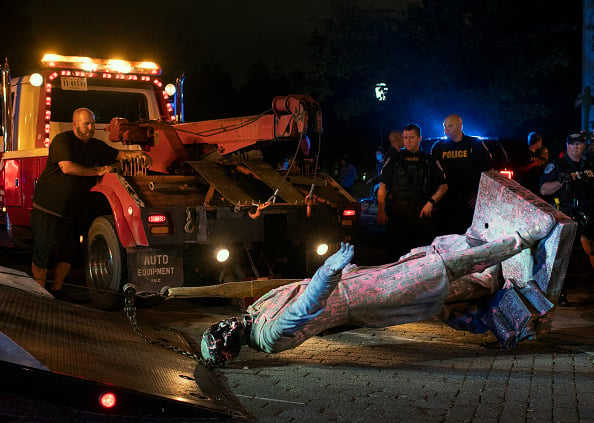
A statue of Confederate President Jefferson Davis is loaded onto a tow truck after it was pulled down off of its pedestal on Monument Avenue in Richmond, Virginia, on June 10, 2020. Courtesy of Getty Images.
The Man In Question: Jefferson Davis was the President of the pro-slavery Confederate States of America from 1861 to 1865. Before the secession of the Southern states, Davis was a member of the Democratic Party and represented Mississippi in the Senate and the House of Representatives. He owned a cotton farm where he had 113 slaves. In contrast to Abraham Lincoln, he is regarded as an uncharismatic leader and was faulted in his day for the many failures of the Confederacy, even though he was later hailed as a hero by Confederate apologists.
Statue Facts: The 8-foot bronze figure on Richmond’s Monument Avenue was erected in 1907 by a Confederate heritage group. Like many Confederate monuments, this one was erected well after the Civil War had ended, beginning in the post-Reconstruction era of the 1890s, when the romanticization of the so-called “Lost Cause of the Confederacy” emerged. The “Lost Cause” reimagined the war as a battle for independence rather than recognizing it for what it was: a clash over the institution of slavery. The rise of Confederate monuments continued well into the 20th century, and became a tactic of repression during the integration era.
The Takedown: The work had been slated for removal by city leaders in the coming months, but demonstrators refused to wait, tying ropes around the statue’s legs and toppling it from its plinth.
Monument Avenue: Richmond has been the site of numerous statue topplings, with damage done to Confederate monuments along the city’s so-called Monument Avenue. Among these is the city’s most infamous: a state-owned equestrian statue of Robert E. Lee, the commander of the Confederate army, which Virginia’s Governor, Ralph Northam, had promised to take down. That order, however, has been temporarily blocked by a local court. The city’s mayor, Levar Stoney, has similarly vowed to remove other municipally owned monuments, including the since-removed Jefferson monument. Kehinde Wiley’s monumental bronze sculpture, Rumors of War, also lines the avenue and is a direct response to such Confederate statues. The statue shows a young African American man, clad in street wear, heroically riding a bucking horse.
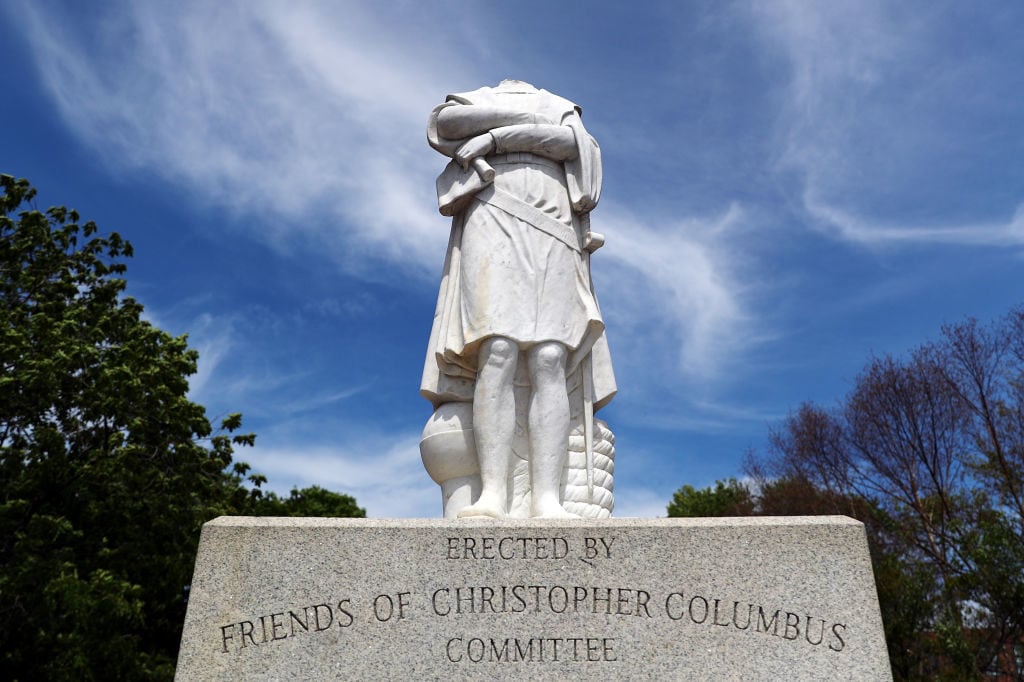
A statue depicting Christopher Columbus with its head removed at Christopher Columbus Waterfront Park on June 10, 2020, in Boston, Massachusetts. Photo: Tim Bradbury/Getty Images.
What Transpired: In Boston on June 9, in the historically Italian neighborhood of the North End, a marble monument to Columbus was beheaded in a park named for the supposed discoverer of the Americas.
Statue Facts: This statue was erected in 1979 and was installed, like many other Columbus monuments, as a symbol of Italian American pride.
Not The First Time: This isn’t the statue’s first decapitation—it happened once before, in 2006. In 2015, the monument was doused in red paint and the words “Black Lives Matter” were spray-painted on its base.
Other Columbuses: In Richmond, Virginia, this week, another statue of Columbus was set aflame, then pulled from its base by nearly 1,000 protestors, who hurled into a nearby lake. That sculpture, which was commissioned by local Italian American residents and completed by Ferruccio Legnaioli, was erected in 1927 as the first depiction of Columbus in the American South. (Also this week, in Minnesota, Native American protestors led the removal of yet another Columbus monument.)
Why It Needed to Come Down: Long-heralded as the discoverer of the Americas, Columbus is now understood to have initiated the trans-Atlantic slave trade and to have opened the Americas to European colonialism. He also is known to have raped indigenous women and notoriously pushed his own crew to force indigenous people into servitude.
Future Fate: Boston’s mayor, Marty Walsh, said that statue would be put into storage. It may or may not be restored.
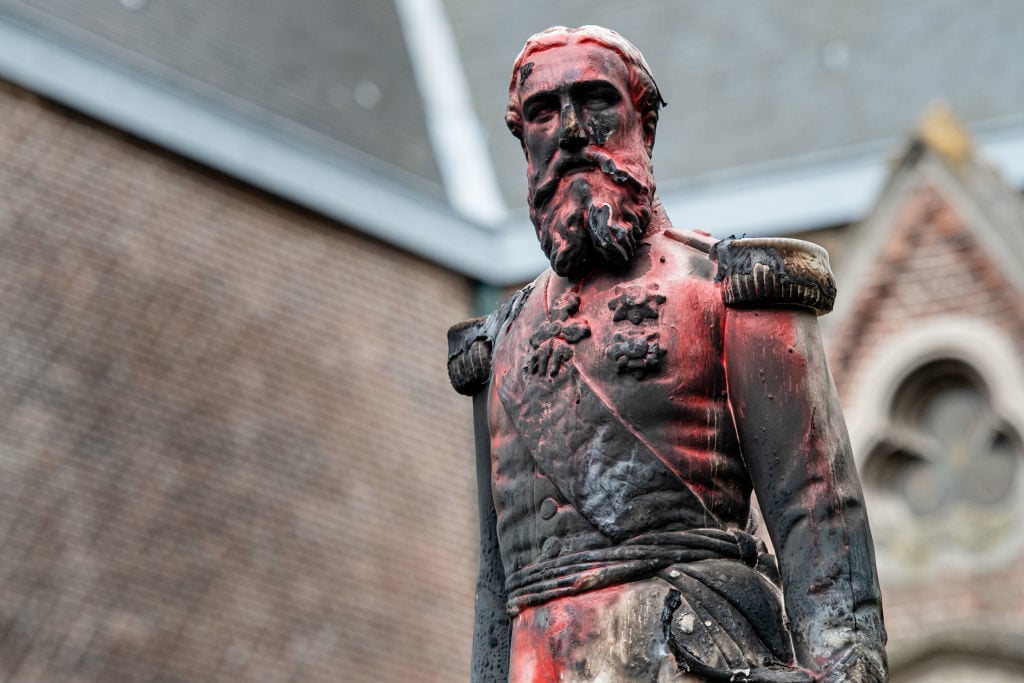
A statue of King Leopold II of Belgium is pictured on June 4, 2020 in Antwerp after being set on fire the night before. Photo by Jonas Roosens/Belga/AFP via Getty Images.
Statue Facts: The notoriously brutal Belgian King Leopold II assumed the throne in 1865 and held it until 1909, making him the longest-reigning monarch in Belgian history. This particular statue, in Antwerp’s Ekeren district, was erected 150 years ago, during his reign.
Crimes Against Humanity: During his kingship, Leopold II founded and owned the Congo Free State, a region of land he claimed in Central Africa for his private enterprise. He had publicly claimed that the venture was an attempt to “civilize” and improve the lives of the native inhabitants; in reality, it was an exploitative and ruthless colonial mission to loot ivory and extract the valuable resource of rubber to fund Leopold’s lavish construction projects in Europe. During his mercenary rule of the Congo Free State, from 1885 to 1908, an estimated 10 million Congolese died (though a precise number is unknown) and countless others were brutally maimed. The term “crime against humanity” was first used in reference to his atrocities.
Back Story: Monuments to King Leopold II have been hotly debated in Belgium since the 1980s, with petitioners demanding that the monuments be removed. Yet Belgium has been slow to grapple with its colonial legacy. During recent protests, this statue, along with other depictions of the monarch throughout the city, were splattered with red paint. Protestors climbed on another statue of Leopold and raised a flag of the Democratic Republic of Congo.
The Takedown: After protestors subsequently set the monument aflame, city officials intervened, sending a crane to remove the monument on Tuesday, June 9.
Future Fate: Officials in Antwerp removed a statue of the monarch and transferred it to storage in the Middelheim Museum. The statue, importantly, has not officially been deinstalled, but only temporarily removed due to damage inflicted by protestors, though it may be quite a while before it sees the light of day.
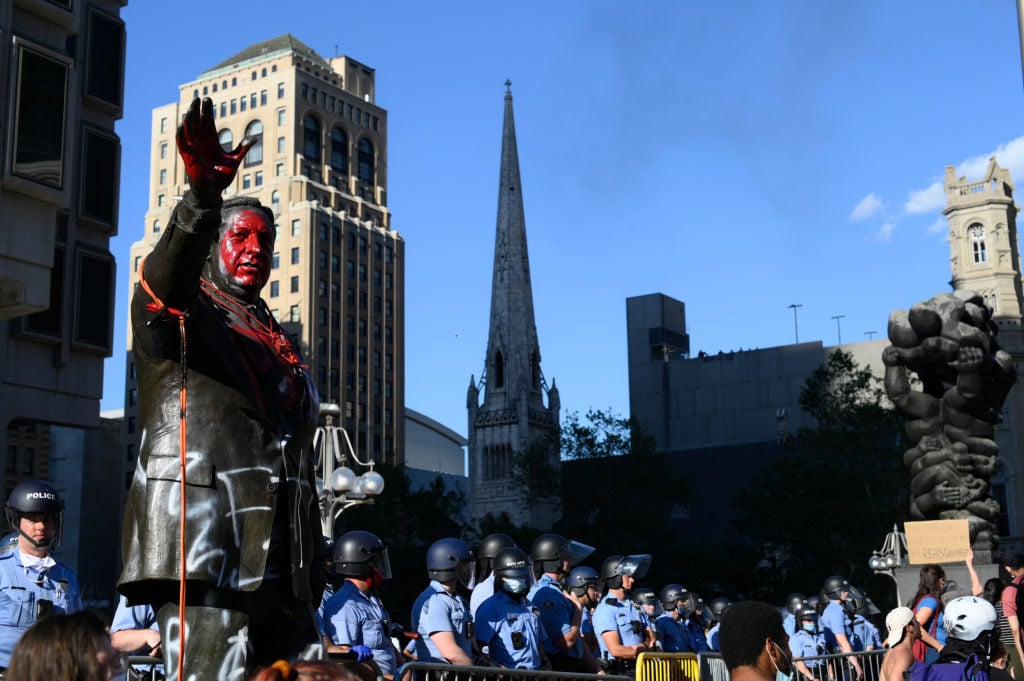
Police officers guard the controversial Frank Rizzo statue as protestors clash with police near City Hall, in Philadelphia, PA on May 30, 2020. Photo by Bastiaan Slabbers/NurPhoto via Getty Images.
Statue Facts: Frank Rizzo acted as Philadelphia’s police commissioner from 1968 to 1971 and was subsequently mayor of the city from 1972 to 1980. The 10-foot likeness of the mayor was erected in 1999, in front of Philadelphia’s City Hall.
Why It Needed to Come Down: Rizzo was widely acknowledged to be a bigot and a bully, and during his tenure in his official positions, he encouraged officers to use excessive force, particularly against Black communities. Moreover, he stood against the desegregation of schools, and, while stumping on this third mayoral campaign, infamously encouraged Philadelphians to “Vote White.” In a statement, current Philadelphia mayor Jim Kenney said: “The statue is a deplorable monument to racism, bigotry, and police brutality for members of the Black community, the LGBTQ community, and many others.”
Backstory: The 10-foot-tall statue has long been on the radar of activists and social-justice reformers who have called for its removal for years, labeling it as a symbol of police brutality and racism. The statue has seen its fair share of vandalism. On May 30, during a Black Lives Matter protest, a crowd lit the statue on fire and attempted to pull it down.
What Transpired: On June 3, 2020, Mayor Kenney signed an immediate order mandating that the city’s managing director remove the statue. At approximately 2 a.m. the next morning, a crane arrived to remove the statue, as crowds cheered on. Even the statue’s sculptor, the artist Zenos Frudakis agreed with the decision, telling the Daily Philadelphian that when he realized what the statue symbolized to the Black community, he knew “it had to come down.” On June 7, the city also painted over a mural of Rizzo in Philadelphia’s Italian Market neighborhood.
Future Fate: After removing the sculpture, the city announced it would be placed in storage by the Department of Public Property for the time being. Any future plans for the statue will need to be approved by the Philadelphia Art Commission.
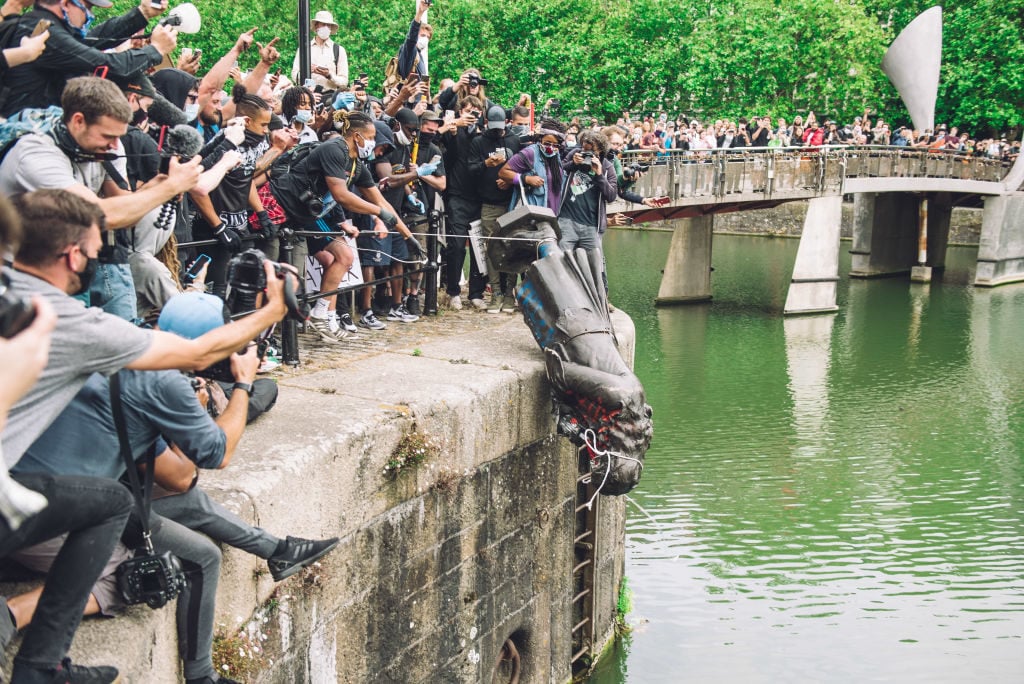
The statue of Colston is pushed into the river Avon. Photo by Giulia Spadafora/NurPhoto via Getty Images.
Statue Facts: Edward Colston was born in Bristol in 1636. An English merchant and member of Parliament, he began his career trading fruits and textiles between Europe, Africa, and the Americas, but later became involved in the Atlantic slave trade through his affiliations with the Royal African Company, which dominated the English trade of slaves. The statue of Colston, designed by John Cassidy, was commemorated in 1895, some 174 years after Colston’s death, and erected in the Bristol city center as a monument to his contributions to the city.
Slave-trader: Colston’s involvement with the Royal African Company lasted from 1680 to 1692. Though the amount of money Colston earned through the slave trade is not known, it is estimated that during his tenure, the company transported approximately 85,000 men, women, and children to the Americas and the Caribbean, of whom 19,000 died on the journey.
Lasting Legacy: Colston’s name is part of Bristol’s urban fabric. He used much of his wealth to fund philanthropic endeavors in his home city, including schools, almshouses, hospitals, and churches, although he enabled those to whom he gave his charitable donations to deny services to those who did not share his religious and political views. Many of these institutions survive to this day.
The Takedown: On June 7, 2020, after tagging the monument with spray paint, demonstrators toppled the statue and pushed it into Bristol Harbour. According to the BBC, the city’s mayor, Marvin Rees, said he felt “no sense of loss” over the statue, Rees, who is of Jamaican descent, remarked: “I cannot pretend it was anything other than a personal affront to me to have it in the middle of Bristol, the city in which I grew up.” Prime Minister Boris Johnson meanwhile described the dismantling as a “criminal act”.
Future Fate: The Bristol City Council pulled the statue from the harbor four days later and took it to a secure location. Officials say it will one day be sent to a museum. The mayor is now calling on historians and academics to help inform that city as to best practices for how to move forward.